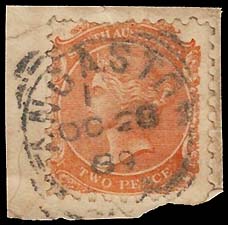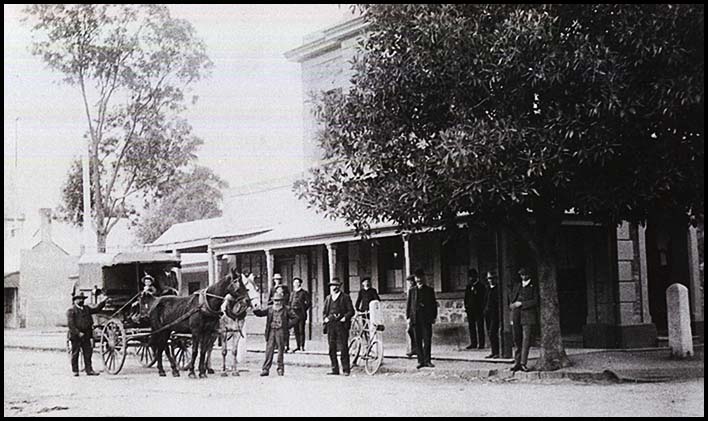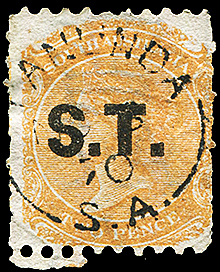Telegraph offices in the Barossa region.
- Home, index, site details
- Australia 1901-1988
- New South Wales
- Overview of NSW
- Telegraph lines
- Telegraph Offices
- Date stamps
- Forms
- Envelopes
- Rates
- Stamps
- Queensland
- Overview of Qld
- Telegraph lines
- Telegraph offices
- Date stamps
- Forms
- Envelopes
- Rates
- Stamps
- South Australia
- Overview of SA
- Telegraph lines
- Telegraph Offices
- Date stamps
- Forms
- Envelopes
- Rates
- Stamps
- Tasmania
- Overview of Tasmania
- General developments
- Reports
- Organisation
- Telegraph lines
- Telegraph Offices
- Date stamps
- Railway lines
- Forms
- Envelopes
- Rates
- Stamps
- Overview of Tasmania
- Victoria
- Overview of Vic.
- Telegraph lines
- Telegraph offices
- Date stamps
- Forms
- Envelopes
- Rates
- Stamps
- Ephemera
- Western Australia
- Overview of WA
- Telegraph lines
- Telegraph Offices
- Date stamps
- Forms
- Envelopes
- Rates
- Stamps
The following Telegraph Offices are referenced on this page:
| Angaston | Eden Valley | Freeling | Greenock | Lyndoch | Mount Pleasant |
| Nuriootpa | Roseworthy | Stockwell | Tanunda | Williamstown |
|
Telegraphic communication was established between Angaston and Adelaide and the Telegraph Office opened on 7 March 1866. In October 1865, the line had been pegged and the erection of the poles was about to start. In the South Australian Register of 9 July, 1868, the following small item appeared: "The Telegraph Office has lately been robbed twice of small sums of money but there is a mystery about the affair, so that we can say little about it".
In July 1879, tenders were called for the construction of a Post and Telegraph Office at Angaston. The Evening Journal of 17 February 1880 reported that four tenders for the construction of the Angaston Post Office and Telegraph Station had been received and the tender by James Wishart was the lowest. In the House of Assembly on 13 October 1880, Mr. Basedow asked "whether the Government would, now the necessary money had been passed in the Estimates, go on without any unnecessary delay with the erection of the Post & Telegraph Office in Angaston. The Commissioner of Public Works said as the House had sanctioned the additional sum necessary, the work would be proceeded with as soon as possible". |
|
| Angaston SA squared circle date stamp.
A strike with this format could have been used on a transmission or a delivery form. Number in the Census used on a telegram form: 0. |
 28 October 1889. |
|
The telegraph line was finished on 11 May 1875 but it had not been opened for the use of the residents (South Australian Register 18 November 1875, p.2). On 16 June 1876, the South Australian Register noted that "The telegraph line has been completed as far as this township for thirteen months and still there are no signs of its being opened for the benefit of the place". A Telegraph Office was opened on 9 October 1876. On 21 November 1882, the South Australian Advertiser reported (p. 7) that "A new post and telegraph office is in course of construction opposite to the hotel. According to the plans, it will be an acquisition to this little township". The South Australian Weekly Chronicle of 3 September 1887 reported that: "The inhabitants of Eden Valley and district are excited at the probability of the post and telegraph office being shifted to the local store, and the postmistress being removed. Miss Chanter has held the position mentioned for about 18 months, and she is esteemed very much. The inhabitants sincerely hope the Minister of Education will not allow the alteration to take place, and a memorial is to be got up to that effect". |
|
The Telegraph line to Greenock was opened on 5 March 1866 by Mr. Todd. The first Telegraph Office in Greenock was opened in a room in the house of Louis Iverson. The Post Office had opened on 1 January 1856. On 20 February 1866, Mr. Rounsevell asked in the House "if the Government have any objection to remove the Post Office at Greenock from the private store to the Telegraph Office and, if not, when such alteration will be made". The answer provided by the Chief Secretary was ""Mr. Minck, of Greenock, is one of the most zealous and attentive Postmasters in the service and the Post Office has been kept for many years in the store occupied by him. There exists no intention of removing the Post Office at Greenock from the store to the Telegraph Station as it was so well managed and the Telegraph Station was merely a branch one". This was all before Greenock even had the line connected!!
The above is reported in full to highlight an important principle of administering the Department. The Bunyip of 10 March 1866 reported that "Mr. Couglin carried his motion for combining the Post Office and Telegraph Office at Greenock" on 7 March. A site was suggested to the Commissioner of Public Works at a meeting on 1 March 1870 for a new Post and Telegraph Office at Greenock East (The Express and Telegraph 7 March 1879, p. 2) on the basis:.
The Commissioner agreed to discuss this site and others with Mr. Todd. |
|
Todd was able to open the telegraphic connection as a branch line from Gawler but thus connecting Lyndoch to Adelaide about 25-28 November 1865. The Telegraph Office opened in 1866. In May 1871, Mr. Newbury - a teacher at the Church of England day-school was appointed Post and Telegraph Master. The offices were removed to their previous premises where the Post Office had been previously. |
As the possibility of a Telegraph Office drew closer to fruition, hints of problems began to emerge:
On 17 October 1865, the South Australian Weekly Chronicle reported that "we expect the Telegraph Office to be opened in the course of two months". The Telegraph Office was opened at Nuriootpa in January 1866 - as a Branch office from Tanunda. It was opened in the local school. The teacher also served as the Operator (multi-tasking!!!). Telegraphic communication was opened to Nurioopta on Tuesday 6 March 1866. The South Australian Advertiser reported on 15 November 1869 (p. 3):
On 30 November 1869, the same newspaper report (p.3):
By 1870, both the Post Office and the Telegraph Office were moved into the one place - that was in Strothers Store. Still the problems continued about the Nuriootpa P&T Office. On 13 September 1878, the South Australian Register (p. 2) noted:
The South Australian Advertiser of 12 April 1879 reported on developments:
Following the deputation of the local community to the Minister of Education, a new building housing both branches was opened at Nuriootpa in 1879. That building was remodelled in 1925 and again in 1991. |
Springton. As Springton was on the line from Mount Pleasant to Eden Valley, it would have been a good choice for the location of an intermediate Telegraph Office. It would also have facilitated the transfer of the Post Office to the main street of the township. No telegraph service was however commenced at Springton. A telephone office was opened in 1888. |
|
A Telegraph Office opened in Stockwell on 16 March 1877. A Post Office had opened on 1 January 1858. |
| Tanunda.
As of 18 November 1865, the Telegraph Office at Tanunda had not yet been finished. It would be opened as soon as a room for the operators was completed.
|
 Tanunda Post & Telegraph Office 1909. |
 Tanunda Post & Telegraph Office in 1905. The left side of the building shown in the top photograph (mainly the bit behind the tree). |
|
The Foundation Stone for the building was laid at a well documented ceremony on 19 June 1865. It was established as an important repeater station serving Lyndoch and Nurioopta through to Stockwell and Truro. Greenock was added sometime later. The Telegraph Office opened in 1866. From 1867, Tanunda was also part of the direct Adelaide-Wentworth-Sydney intercolonial line which also passed through the above stations (excluding Angaston and Greenock). |
|
| The story of the appointment of a 14 year old boy named Schroeder in 1878 as a messenger at Tanunda gives a most revealing account of the operation and development of telegraphy in South Australia. | |
| Tanunda unframed date stamp. |  8 November 1870. ST in black. Perf 10. Rouletted. Crown over SA watermark. |
|
The Telegraph Office opened on 20 November 1866. On 12 September 1878, it was reported that the foundation was being laid for a new Post and Telegraph office. |
|
One of the first mentions of a telegraph for Williamstown came up at a public meeting of about 20 persons at Snellgrove's Hotel on 7 December 1871 in preparation for a forthcoming election:
At another public meeting of ratepayers in Williamstown on 7 May 1878, the question of extending the telegraph line to Williamstown was considered. The unanimous feeling was that little cost would be involved for construction but that significant benefits would accrue to the township. A Committee was formed to expedite the matter. On 12 August 1878, the Committee received a letter from the Minister of Telegraphs (Ed. there was no such appointment - it may have been the Superintendent of Telegraphs) declining to grant the telegraph requested. The Committee considered the rejection must have rested on the expense of trained operator. Therefore it was decided to prepare a memorial for a telephone to Lyndoch which they thought would cost about £100 for the poles, wires and instruments plus connection costs. One person saw great potential for the Williamstown telegraph and sent his views to the Gawler Standard which published them on 1 November 1879:
The South Australian Chronicle of 27 March 1880 reported that "Our new Post and Telegraph Office is finished and the latter only wants the poles and wires". The line was built as a branch from Lyndoch. That announcement was followed up in the Gawler Standard of 3 April: "The new Post and Telegraph Office at Williamstown has been opened, but the telegraph line is not constructed yet. Tenders were called some time ago for the work, but some of the tenders were regarded as too high and others informal. Fresh tenders, it is understood, will be called shortly will be called shortly". On May 8 there was another announcement in the South Australian Chronicle that "The contractor is getting on as fast as possible with the erection of the telegraph poles. He has about one mile more to erect to reach Sandy Creek. The heavy rains have delayed the carting of the poles, as our roads are in a fearful state, especially between the South Para and Victoria Creek, Maidstone branch". Good news - the South Australian Chronicle of 12 June 1880 reported that "Our telegraph line (from Gawler and Lyndoch) was completed on 7 June and we expect it to be opened in a few days". Finally the South Australian Register of 19 June 1880 carried the welcome story that:
|
